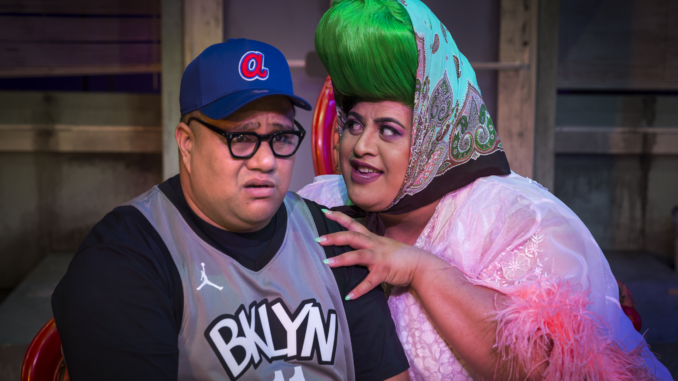
[Camp Confectionary]
I’ve always had a strange relationship with musical theatre, a genre that demands a level of sentimentality I don’t always believe it earns. In a way a musical has to work a lot harder to move me, maybe because deep down I can feel the wheels turning. The emotional beats too easily replaced by songs, arcs rushed, etc.
Lyricist Howard Ashman and composer Alan Menken’s 1982 musical Little Shop of Horrors avoids the trap of sentimentality by leaning into musical theatre’s other defining characteristic: camp. Intentional camp, to be specific, offers a self-aware or knowing wink to avoid cheap emotion. None of this is real, none of this is to be taken too seriously, but we’re going to give 100 percent is the contract between audience and performers.
Based on the Roger Corman American b-movie classic of the same name, Little Shop of Horrors is at its core about a flower shop assistant Seymour (Rutene Spooner) who unknowingly nurses a man-eating plant, Audrey II, named after the girl he likes. The plot is thin, but it gets a lot of mileage out of a premise that might read as a short sketch on paper. The narrative is also buoyed by the love story between Seymour and the original Audrey (Monique Celmentson) who he works with. While romance isn’t the main appeal of Little Shop of Horrors, actors Spooner and Clemenston perform like it definitely is.
The theme of trauma and violence that damages self-esteem is a strangely prominent strand in the musical. Both Audrey and Seymour are the products of harmful and parasitic relationships, either from their surrogate fathers or lovers. There’s the implication that these human relationships might be just as toxic or destructive as Audrey II’s appetite. It’s an impressive balancing act to create something this dark that doesn’t appear so. But it succeeds, appearing like nothing other than pure escapism. It might be nihilistic if it wasn’t so much fun.
The musical never dwells on these ideas too long. They’re tropes rather than themes, but they are present and drive the hard-knock-life of the world the characters inhabit. No wonder a faustian deal with the devil is so appealing. And it’s one we relish in. As much as Seymour is our audience surrogate, the audience is always rooting for the infamous man-eating plant, Audrey II, agent of chaos, to burn it all down.
In a strikingly modern move, this production does away with the iconic puppetry of Audrey II for a personification in the shape of performer Brady Peeti, whose voice and knowing face is easy to cheer on. It’s a bold choice by director Benjamin Henson, but one that pays off in separating itself as more than just a carbon copy of the American classic and something with a uniquely Kiwi stamp on it.
It’d be disingenuous to ignore the casting of two Māori leads as being anything other than spectacular. Peeti and Spooner get to inhabit roles that are most certainly not written for them as far as the canon is concerned, yet inhibit the roles with such sincerity. And maybe it’s unfortunate it has to feel that way, but this tiny victory is noted. Despite the excess of camp, there’s nothing ironic about the casting. The casting is straight-faced, though the performers are anything but. It might feel like a tokenistic gesture if it didn’t work so well. After all, if you are having New Zealanders play Americans, why not have New Zealanders of a broad scope?
The rest of the cast are equally stunning, with no weak link in sight. Ezra Williams, Jane Leonard and Kristin Paulse make for superb doowop girls who also function as a modern Greek chorus. Jonathan Martin makes for a suitably grubby and greedy Mr Mushnik. Though it is perhaps Court regular Roy Snow as bad boy and sadomasochistic dentist Orin who steals the show. It’s a scenery chewing role that Snow relishes, the genuine perversity leaving the audience in stitches.
Dan Wiliam’s set and costumes are also eye-popping in its colours. The greens in particular call to mind the Wizard of Oz’s Emerald City, contrasting with the pinks and their cotton candy goodness. It’s utter confectionary for the eyes. No, this is not a period piece, despite the rough 1960s New York setting. It is pure fantasy. Not to mention a series of set and costume transformations that make great use of the scale of the entire Court stage, morphing like Audrey II herself to surprise us.
If the show strains at any point, it is mostly in bumping up against the limitations of the plot. If the production feels fresh, the script doesn’t always match it. The ending doesn’t really work, petering out when it should climax. It’s suddenly all over, though that is also a testament to the pace of it all. If it never quite transcends its plot or structure, no one really watches Little Shop for its plot anyway. The script is just a vehicle to explore camp as a theatrical style and genre unto itself. The weirder it gets, the better it is.
Why this? Why now? It’s a boring dramaturgical question, but one that is hard to ignore when reviving a cult classic of the musical repertoire. One that feels quintessential American at that. Escapism is as good a reason as any. But I think the casting does something pretty incredible. To see a classic of the western canon given a reworking to platform and spotlight artists who historically would never be cast in it is nothing short of magic.
Now that’s escapism with a sly political heart beating underneath.
Little Shop of Horrors plays Court Theatre 20 November 2021 to 15 January 2022.

Leave a Reply